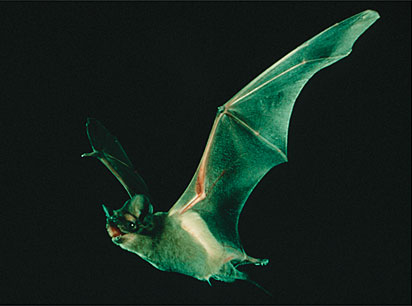This is a species that's close to my heart. Just a short drive from my home in Davis, California underneath a freeway bridge that takes cars over the Vic Fazio Yolo Wildlife area (the largest wetland restoration project west of Florida) to Sacramento, roost a colony of an estimated quarter of a million of these bats.
Weighing in at just 15g and measuring 9cm in length, their size is not so special; they are classed as medium sized members of the chiroptera. These furry fellows range from reddish-brown to grey in colour and possess large black ears, characteristic of their brethren; "all the better for echolocating you with my dear", which pushes them into the sub-realm of the microchiroptera (bats that use echolocation to 'see').
Their moniker (Mexican free-tailed bat, also commonly known as the Brazilian free-tailed bat) stems from their geographic range (from the Western and Southern US, to Mexico and South America, as far south as parts of Chile and Argentina) and the fact that they possess a tail that extends beyond the flight membrane (originally thought to have been a gliding adaptation, the flight membrane typically extends between the feet of most bats and is used for stabilising themselves during flight and catching prey).

Anyone who has ever watched a bat flitting through the night sky bore witness to the fact that they are adept and agile flyers, often coming within a hair's distance of the top of your head, which tends to make them pretty unpopular with people who value their personal space. The Mexican Free-Tail is
particularly well adapted to fast flight, literally blink and you'll miss them. They possess long, narrow wings with pointed tips and long hairs on their toes that act as their dashboard flight instruments, enabling them to judge flight speed and assess turbulence. They leave the roost at speeds of up to 35mph, but once out in the open air they can reach speeds of 40-60mph. Maintaining these speeds requires a considerable amount of energy, and indeed they feed for longer than any other species every night, travelling as far as 30 miles from the roost and up to 10000 feet into the air in search of their prey, which is typically insects such as moths and mosquitoes. They can eat their body weight in food every night, putting that into perspective it's like a 100lb human eating 400 quarter-pounders, enough to keep McDonald's in business for a while. The fact that they eat so many insects is a great asset to the local environment and us humans, helping to keep the insect pest populations in check.

A collaboration between two Texas Universities and Bat Conservation International observed that male Free-Tails from different regions use mating calls made up of similar phrases and syllables to attract females, in essence they sing their love songs from the same sheet music. The females are impregnated but they delay the implantation of the embryo so that they actually become 'pregnant' in March or April, upon arrival at their summer nesting sites.
The females live together in these large maternity colonies, whilst the males nest in separate colonies close by. Females give birth to one baby per year, after a 90-day gestation period, over the course of about 5 years of their lifetime. Each female in the colony gives birth within the space of about 5 days. The babies are close to one third the size of mum, at the risk of causing synchronised leg crossing and wincing amongst female readers, that's like giving birth to a kindergartner. They huddle together in the higher reaches of the roost, which serve as an insulated nursery. Hungry mums leave their babies just before sunset each day and return shortly before dawn to nurse, each mother appears to almost exclusively nurse her own baby, unless she mistakenly identifies the wrong one. It is unclear exactly how mum and baby are able to recognise one another in the furore, but research indicates it could be that each female scent marks her own baby or that each baby recognises a distinct directive call from mum, possibly a combination of both.
The young bats develop over 6 weeks, a much slower rate than other bat species, before they prepare to leave the roost and fly for the first time. Watching a Free-Tail flyout is an impressive affair. These bats typically roost in caves, but also make use of cave-like man-made structures like underneath bridges or in abandoned buildings. In a technique thought to outsmart any awaiting predators like hawks, owls, skunks or raccoons, the Free-Tails huddle close to the entrance of the roost and then all of a sudden streams of thousands of bats emerge together, like a biblical plague, except that they are out to eat the pests themselves. Interestingly, the same behaviour also occurs prior to re-entering the cave.
Bats are amongst the most long-lived of all mammals and the Mexican Free-Tail is no exception, potentially living as long as 18 years. Studies carried out in this particular species have tried to determine why bats live so much longer than other mammals of a similar size, such as mice. It's believed that part of the reason may be that the cells of their body are better able to prevent a toxic build up of proteins that is associated with diseases of ageing. Despite their large numbers Free-Tail bats are a protected species, since the fact that they nest in such large colonies actually leaves them vulnerable to human interference or any changes in the local environment, in this case it's not necessarily safety in numbers.



Comments